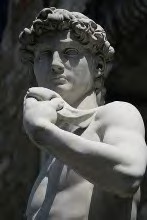 There’s a quote about sculpting, attributed to Michelangelo, that I often paraphrase for students when I’m talking about the art of revising:
There’s a quote about sculpting, attributed to Michelangelo, that I often paraphrase for students when I’m talking about the art of revising:
In every block of marble I see a statue as plain as though it stood before me, shaped and perfect in attitude and action. I have only to hew away the rough walls that imprison the lovely apparition to reveal it to the other eyes as mine see it.
A first draft is often written in a kind of overdrive, with words spinning across the paper without thought to whether they all belong. That’s a valid drafting technique, but a writer can’t stop there (however much most students want to), because that first draft acts as a block of marble. It includes such an excess of words that they imprison the perfection inside. It is only by revising — hewing away the excess — that the essential story, poem, or essay is revealed.
Picture books are one of the best tools I’ve found for teaching the beauty of “less is more” in writing. They are fantastic writing examples even for students who are well past reading them on a regular basis — including middle school and high school writers. The compact packages make for a quick study, and the best are great examples of storytelling, poetic language, the clear but evocative delivery of information, and sensory images.
Some of my past favorites that work well with older students include City Dog, Country Frog by Mo Willems, A Leaf Can Be by Laura Purdie Salas, and Chopsticks by Amy Krouse Rosenthal.
Read them, talk about them, and then encourage your students to take out the chisels and get to work!
